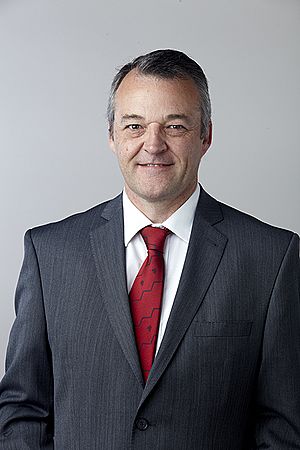Steven Armes facts for kids
Quick facts for kids
Steve Armes
|
|
|---|---|

Steve Armes at the Royal Society admissions day in 2014
|
|
| Born |
Steven Peter Armes
1962 (age 62–63) |
| Education | Whitley Abbey Comprehensive School |
| Alma mater | University of Bristol (BSc, PhD) |
| Awards | Tilden Prize |
| Scientific career | |
| Institutions |
|
| Thesis | Colloidal forms of conducting polymers (1987) |
| Doctoral advisor | Brian Vincent |
Steven Peter Armes (born 1962) is a top scientist. He is a Professor of polymer chemistry and colloid chemistry at the University of Sheffield. He studies how to make and use special long-chain molecules called polymers.
Contents
Early Life and Education
Steven Armes went to Whitley Abbey Comprehensive School in Coventry. He then studied at the University of Bristol. In 1983, he earned a Bachelor of Science degree. Later, in 1987, he completed his PhD. His research was guided by Brian Vincent.
Career and Research
After finishing his studies, Professor Armes worked at Los Alamos National Laboratory. In 1989, he became a lecturer at the University of Sussex. He taught there until 2004.
In 2004, he moved to the University of Sheffield. There, he became a Professor of Polymer and Colloid Chemistry. His team researches how to create new polymers. Polymers are long chains of smaller units. They use special methods to build these chains.
What is Polymer Chemistry?
Polymer chemistry is about making and studying polymers. Polymers are giant molecules. Think of them like a long train made of many identical cars. These "cars" are called monomers. Plastics, rubber, and even DNA are polymers.
Professor Armes's team creates polymers that can dissolve or spread out in water. They use special methods to build these molecules.
Polymerization-Induced Self-Assembly (PISA)
One cool method they use is called Polymerization-Induced Self-Assembly, or PISA. Imagine you have a polymer that likes water. They can attach a new part to it that does not like water. As this new part grows, the molecule folds itself into tiny shapes. These shapes are called copolymer nanoparticles.
These tiny nanoparticles can be made into different sizes and shapes. They have many uses. For example, they can help store stem cells for a long time. They can also make liquids thicker or create tiny capsules. Some even work as lubricants.
Other Research Areas
Professor Armes also designs special gels and tiny bubbles (vesicles). These are made from materials that are safe for living things. He also works on tiny nanocomposite particles. These particles can be used in paints and special coatings. These coatings can stop light from reflecting too much.
He also works with space scientists. He creates materials that act like tiny space rocks. This helps scientists understand how micrometeorites behave in space.
Awards and Honours
Professor Armes has received many awards for his work. In 2014, he was elected a Fellow of the Royal Society (FRS). This is a very high honour for scientists in the United Kingdom.
In 2013, he was given the Tilden Prize. This award comes from the Royal Society of Chemistry. It recognized his amazing work in polymer science.

